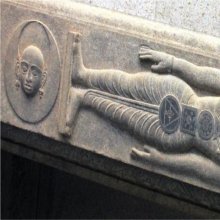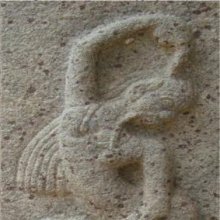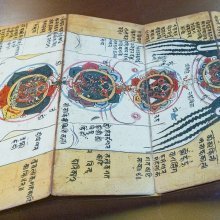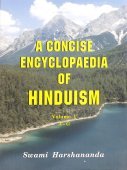Sahasrara, Sahasrāra, Sahastrara, Sahasra-ara: 14 definitions
Introduction:
Sahasrara means something in Hinduism, Sanskrit, Jainism, Prakrit. If you want to know the exact meaning, history, etymology or English translation of this term then check out the descriptions on this page. Add your comment or reference to a book if you want to contribute to this summary article.
Images (photo gallery)
In Hinduism
Yoga (school of philosophy)
Source: Chakras: HinduismSahasrāra = thousand, infinite. The Sahasrāra Chakra is located on the crown of the head beneath the Fontanelle, which is easily visible in a new-born child. It is also known as the Thousand-petalled Lotus, Brahmrandhra (door to Brahma) and Source of Light (because a supernatural light as bright as the sun radiates from it).
No other light approaches the brilliance of the sun. In the same way the radiance of all other Chakras fades before the incomparable radiance of the Sahasrāra Chakra. The Sahasrāra possesses no special colour or quality. Its light contains all colour vibrations united in the incomparable brilliance of pure light. The energy of all Nādīs flows together here, just as the water of a thousand rivers comes together in the sea.

Yoga is originally considered a branch of Hindu philosophy (astika), but both ancient and modern Yoga combine the physical, mental and spiritual. Yoga teaches various physical techniques also known as āsanas (postures), used for various purposes (eg., meditation, contemplation, relaxation).
Shaktism (Shakta philosophy)
Source: Google Books: ManthanabhairavatantramSahasrāra (सहस्रार) refers to the “thousand-spoked wheel (in the head)”, according to the Lalitāsahasranāma.—Lalitā’s thousand names are eulogized in the Lalitāsahasranāma, describing the goddess’s spiritual beauty on the analogy of physical, sensuous beauty. [...] The goddess’s inner secret is her marital sport in which the worshipper inwardly participates. This secret sacrifice (rahasyayāga) is the ‘inner sacrifice’ (antarayāga) described in the Bhāvanopaniṣad. It is the realisation of the unity of 1) Śrīcakra and the bodies, subtle, gross and causal; 2) the lunar orb (candramaṇḍala) in the thousand—spoked wheel in the head (sahasrāra) and the Point in the centre of Śrīcakra called ‘Made of All Bliss’ (sarvānandamayabindu); 3) the individual and universal Self, Śiva and Śakti, the Light (prakāśa) of consciousness and its reflective awareness (vimarśa). [...]”.
Source: DSpace at Pondicherry: Siddha Cult in Tamilnadu (shaktism)Sahasrāra (सहस्रार).—The highest cerebral region is known as sahasrāra. Through yogic exercise this kuṇḍalini-śakti has to be pushed up through the two main nerves, iḍa and piṅgala, so that it may reach the sahasrara or the highest cerebral region where it should meet its source. Then the nectar which reached the sahasrāra is consumed by the yōgic practitioner forms the final stage of this kuṇḍalini-yoga.

Shakta (शाक्त, śākta) or Shaktism (śāktism) represents a tradition of Hinduism where the Goddess (Devi) is revered and worshipped. Shakta literature includes a range of scriptures, including various Agamas and Tantras, although its roots may be traced back to the Vedas.
General definition (in Hinduism)
Source: WikiPedia: HinduismSahasrara, is the seventh primary chakra, according to Hindu tradition.
The Sahasrara, or white lotus, is located either at or slightly above the top of the head. (see Sahasrara system of minor chakras below).
The Sahasrara is described as having 1,000 multi-colored petals, which are arranged in 20 layers, each of them with approximately 50 petals. The pericarp is golden and a circular moon region is inscribed on it with a downward pointing triangle.
Function:
The Sahasrara Chakra symbolises detachment from illusion; an essential element in obtaining supramental higher consciousness of the truth that one is all and all is one.
Often referred to as a thousand-petaled lotus, it is said to be the most subtle chakra in the system, relating to pure consciousness, and it is from this chakra that all the other chakras emanate. When a yogi is able to raise his/her kundalini, energy of consciousness, up to this point, the state of Nirvikalpa Samādhi is experienced. This stage is said to bring about rebirth or the siddhis, occult powers, of transforming into the divine, and being able to do whatever one wishes.
In some schemes of chakras, there are actually several chakras that are all closely related at the top of the head. Rising from Ajna, we have the Manas chakra on the forehead, which is closely associated with Ajna. Above Manas there are Bindu Visarga at the back of the head, Mahanada, Nirvana, which is located on the crown, Guru, and the Sahasrara proper, located above the crown.
In Jainism
General definition (in Jainism)
Source: Wisdom Library: JainismSahasrāra (सहस्रार) refers to a heavenly abode (kalpa) inhabited by Kalpopapanna gods, according to Jain cosmological texts in both the Śvetāmbara and Digambara tradition. The Kalpopapannas (‘those born in the heavens’) represent a sub-species of the Vaimānika gods, which in turn represents the fourth main classification of devas (gods). This kalpa is also known as Sahasrārakalpa. In this specific kalpa, instead of bodily coition, a more and more refined sort of sexual satisfaction takes its place. The associated leśyā is white. There are ten such kalpas being ruled over by sixty-four Indras (heavenly kings).
In Jain iconography, the associated animal symbol of the Sahasrāra-kalpa is a elephant (prakrit: gaya, sanskrit: gaja). These animals are depicted in a cosmological text of the Śvetāmbara tradition known as the Saṃgrahaṇīratna (“jewel of the compilation”), also known as the Trailokyadīpikā (“illumination of the triple world”), written by Śrīcandra in the 12th century.
Source: archive.org: TrisastisalakapurusacaritraSahasrāra (सहस्रार) is the son of Vidyādhara-king Aśanivega from Rathanūpura, according to the Jain Ramayana and chapter 7.1 [origin of the rākṣasavaṃśa and vānaravaṃśa] of Hemacandra’s 11th century Triṣaṣṭiśalākāpuruṣacaritra: an ancient Sanskrit epic poem narrating the history and legends of sixty-three illustrious persons in Jainism.
Accordingly:—“[...] Ghanodadhiratha bestowed the kingdom, Kiṣkindhā, on his son, named Kiṣkindhi, took initiation, and attained emancipation. Now in the city Rathanūpura on Mt. Vaitāḍhya at that time there was a Vidyādhara-king, Aśanivega. He had a son, Vijayasiṃha, victorious, and a second, Vidyudvega, like additional arms for him. [...] One day King Aśanivega, in whom a desire for emancipation had arisen, bestowed the kingdom on his son, Sahasrāra, and took initiation. [...]”.
Source: Encyclopedia of Jainism: Tattvartha Sutra 4: The celestial beings (deva)Sahasrāra (सहस्रार) refers to one of the sixteen heavens (kalpa) hosting the sixteen classes of empyrean celestial beings (vaimānika), according to the 2nd-century Tattvārthasūtra 4.19. The living beings residing in the vimānas are called the empyrean gods (vaimānika) and represents one of the four classes of Devas.
What is the number of layers in Satāra and Sahasrāra heaven pairs? There is one layer there. Which thought-colourations are there in Śukra-Mahāśukra and Satāra-Sahasrāra gods? They have pink and white thought-colouration. What is the maximum lifespan of deities in Śatāra-Sahasrāra kalpas? It is slightly more than eighteen ocean-measured-periods (sāgara) for both.

Jainism is an Indian religion of Dharma whose doctrine revolves around harmlessness (ahimsa) towards every living being. The two major branches (Digambara and Svetambara) of Jainism stimulate self-control (or, shramana, ‘self-reliance’) and spiritual development through a path of peace for the soul to progess to the ultimate goal.
Languages of India and abroad
Sanskrit dictionary
Source: DDSA: The practical Sanskrit-English dictionarySahasrāra (सहस्रार).—a kind of cavity in the top of the head, resembling a lotus reversed (said to be the seat of the soul).
Derivable forms: sahasrāraḥ (सहस्रारः), sahasrāram (सहस्रारम्).
Sahasrāra is a Sanskrit compound consisting of the terms sahasra and ara (अर).
Source: Cologne Digital Sanskrit Dictionaries: Shabda-Sagara Sanskrit-English DictionarySahasrāra (सहस्रार).—n.
(-raṃ) The top of the head, the seat of the soul. E. sahasra, and ara a spoke.
Source: Cologne Digital Sanskrit Dictionaries: Monier-Williams Sanskrit-English Dictionary1) Sahasrāra (सहस्रार):—[from sahasra] mfn. th°-spoked, [Bhāgavata-purāṇa]
2) [v.s. ...] m. n. a kind of cavity said to be found in the top of the head and to resemble a lotus reversed (fabled as the seat of the soul), [cf. Lexicographers, esp. such as amarasiṃha, halāyudha, hemacandra, etc.]
Source: Cologne Digital Sanskrit Dictionaries: Yates Sanskrit-English DictionarySahasrāra (सहस्रार):—(raṃ) 1. n. Top of the head.
Source: DDSA: Paia-sadda-mahannavo; a comprehensive Prakrit Hindi dictionary (S)Sahasrāra (सहस्रार) in the Sanskrit language is related to the Prakrit word: Sahassāra.
[Sanskrit to German]
Sanskrit, also spelled संस्कृतम् (saṃskṛtam), is an ancient language of India commonly seen as the grandmother of the Indo-European language family (even English!). Closely allied with Prakrit and Pali, Sanskrit is more exhaustive in both grammar and terms and has the most extensive collection of literature in the world, greatly surpassing its sister-languages Greek and Latin.
Kannada-English dictionary
Source: Alar: Kannada-English corpusSahasrāra (ಸಹಸ್ರಾರ):—[adjective] having one thousand (or a large number of) teeth (said of disc-weapons as of Viṣṇu).
--- OR ---
Sahasrāra (ಸಹಸ್ರಾರ):—
1) [noun] = ಸಹಸ್ರದಳಕಮಲ - [sahasradalakamala -] 2.
2) [noun] a disc-weapon (as of Viṣṇu) which has one thousand (or a large number of) cutting teeth.
3) [noun] the fifteenth of the sixteen Jaina heavens.
Kannada is a Dravidian language (as opposed to the Indo-European language family) mainly spoken in the southwestern region of India.
See also (Relevant definitions)
Partial matches: Sahasra, Ara.
Starts with: Sahasraraja, Sahasrarakalpa, Sahasrarashmi, Sahasrarashmitanaya.
Full-text (+50): Sahasrarakalpa, Kundalini, Cakra, Sahasraraja, Sahassara, Vaimanika, Shrim, Shatara, Mahanada, Geya-cakra, Citrasundari, Dattavirya, Khecarimudra, Rupatita, Satyashri, Svadhishthana, Kalpa, Shatcakra, Chatra, Damadhara.
Relevant text
Search found 28 books and stories containing Sahasrara, Sahasrāra, Sahastrara, Sahasra-ara; (plurals include: Sahasraras, Sahasrāras, Sahastraras, aras). You can also click to the full overview containing English textual excerpts. Below are direct links for the most relevant articles:
Tattvartha Sutra (with commentary) (by Vijay K. Jain)
Verse 4.19 - The sixteen Kalpa, nine Graiveyaka and five Anuttara < [Chapter 4 - The Celestial Beings]
Verse 4.29 - Lifetime in the first two Kalpa among the heavenly beings < [Chapter 4 - The Celestial Beings]
Verse 4.31 - Lifetimes of Deva from Brahmaloka to Acyuta kalpa < [Chapter 4 - The Celestial Beings]
Cidgaganacandrika (study) (by S. Mahalakshmi)
Verse 227-228 [Sahasrāra and shower of Somarasa] < [Chapter 4 - Fourth Vimarśa]
Verse 101 [Nāda’s path] < [Chapter 3 - Third Vimarśa]
Verse 96 [Praṇava produced by Cakrapañcaka in Kuṇḍalinī] < [Chapter 3 - Third Vimarśa]
Paduka-panchaka (the five-fold footstool) (by Arthur Avalon)
Shat-cakra-nirupana (the six bodily centres) (by Arthur Avalon)
Trishashti Shalaka Purusha Caritra (by Helen M. Johnson)
Part 6: Varuṇā’s third incarnation < [Chapter II - Previous births of Pārśvanātha]
Part 32: Description of the Upper World (ūrdhvaloka) < [Chapter III - The initiation and omniscience of Ajita]
Part 5: Marubhūti’s third incarnation < [Chapter II - Previous births of Pārśvanātha]
Bhagavati-sutra (Viyaha-pannatti) (by K. C. Lalwani)
Part 12 - On celestial positions < [Chapter 2]
Part 8 - Monk Kurudattaputra and other heavens < [Chapter 1]
Part 1 - Poisonous beings < [Chapter 2]
Related products





